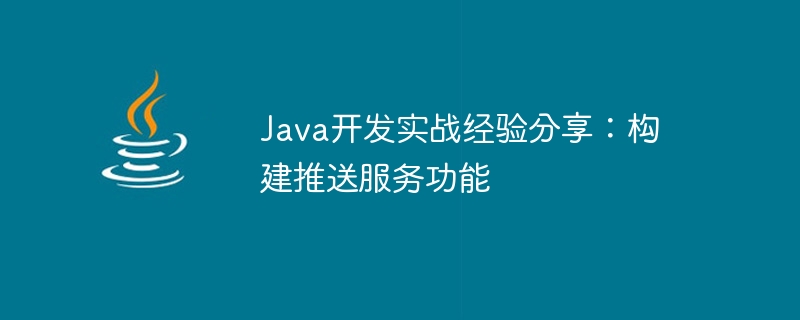Home >Java >javaTutorial >Java development practical experience sharing: building push service functions
Java development practical experience sharing: building push service functions
- PHPzOriginal
- 2023-11-20 15:43:101033browse

Java development practical experience sharing: building push service functions
With the popularization of the Internet and the rapid development of mobile devices, push services have become an important part of modern application development component. Whether it is social media, e-commerce platforms or instant messaging applications, push services play an extremely important role. In order to provide timely message notifications, scheduled task reminders, personalized push and other functions, developers need to master the technology of building push services.
This article will introduce how to use Java language to develop and implement an efficient and reliable push service function. The following will provide a detailed analysis and explanation of push principles, push service architecture, push performance optimization, etc.
1. Push Principle
The basic principle of push service is to push messages to the client in real time through the server, and the client can be a mobile device, web browser, etc. In practical applications, push services are divided into two types: long connection push and short connection push.
Long connection push means that the client and the server always maintain a connection. When a new message arrives, the server immediately pushes the message to the client. This method is highly efficient, but requires certain network resources.
Short connection push means that the client regularly sends requests to the server. After receiving the request, the server checks whether there are new messages and pushes the messages to the client. The advantage of short connection push is that it consumes relatively less resources and is suitable for some scenarios that do not require high real-time performance.
2. Push service architecture
When developing push service functions, a key issue we need to consider is the scalability of the service. A highly scalable push service architecture should meet the following requirements:
- Message queue: The push service needs to classify and distribute messages according to certain rules. This requires the use of message queues to save and manage messages to be pushed, and to support highly concurrent read and write operations.
- Route distribution: The push service needs to push the message to the correct client. This requires a routing distribution mechanism to route messages to the corresponding client based on the client's subscription information.
- High availability: The push service needs to ensure high availability, that is, when a node fails, other nodes can take over its work to ensure the continuity of the service.
Based on the above requirements, a typical architecture of a push service can be composed of the following components:
- Push service node: responsible for receiving and processing push requests and pushing messages To clients that subscribe to the message.
- Message queue: used to save messages to be pushed.
- Routing distribution module: Route messages to the correct client based on the client's subscription information.
- Cluster management module: Ensure the high availability of push services.
3. Push performance optimization
In order to ensure the performance of the push service, we can take the following optimization measures:
- Asynchronous processing: push service Some time-consuming operations involved, such as database queries, network requests, etc., can be processed asynchronously to avoid blocking the main thread.
- Compressed data: Pushed messages usually contain text, pictures, etc. In order to reduce the amount of data transmitted over the network, the message content can be compressed.
- Caching strategy: Some data in the push service, such as user subscription information, message history, etc., can be cached to improve data reading and writing performance.
- Load balancing: If the request volume of the push service is relatively large, you can consider using load balancing to distribute the requests to different nodes for processing to improve the processing capacity of the service.
Conclusion
This article introduces the basic principles and architecture of using Java to develop and implement push service functions, and explores several common methods for optimizing push service performance. I hope that through the introduction of this article, readers can understand how to build an efficient and reliable push service function to provide better user experience and service performance. As a Java developer, mastering the technology of push services will bring you more flexibility and innovation in application development.
The above is the detailed content of Java development practical experience sharing: building push service functions. For more information, please follow other related articles on the PHP Chinese website!

